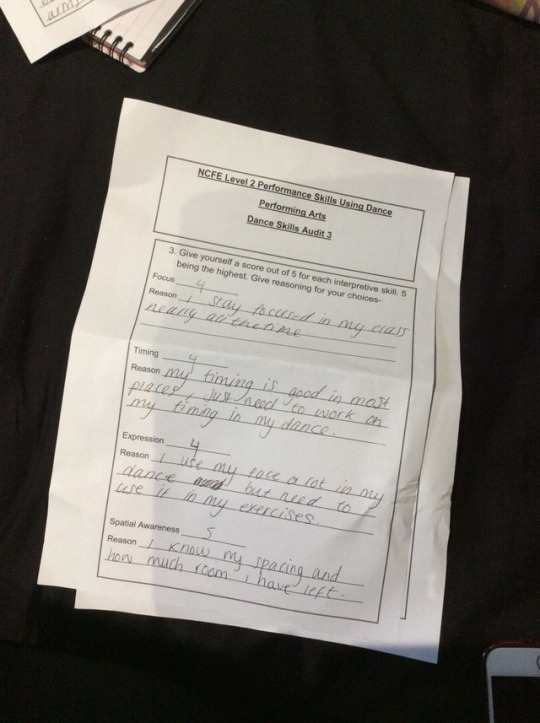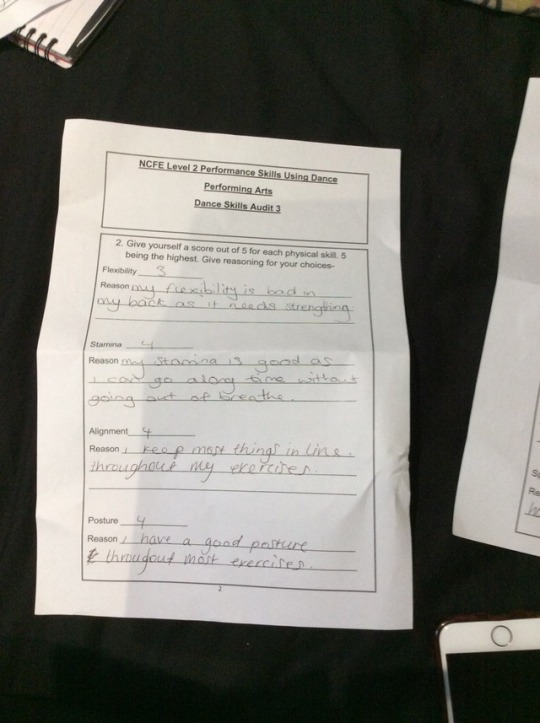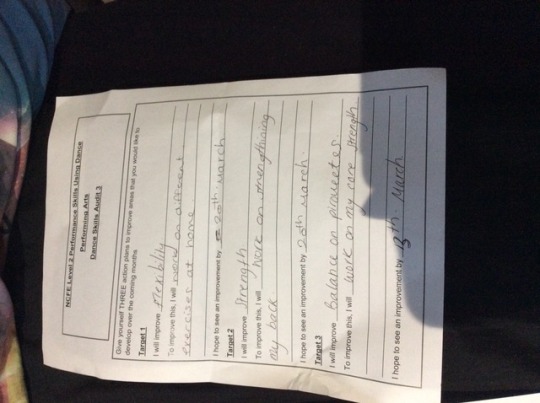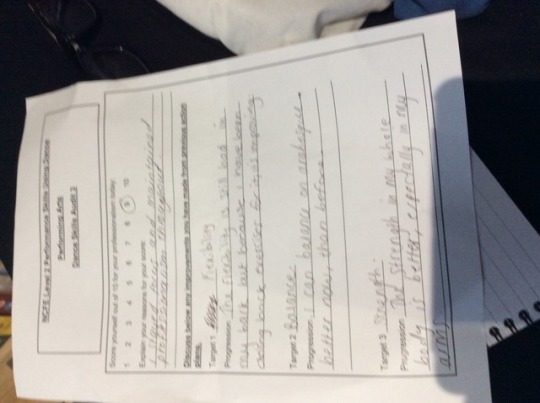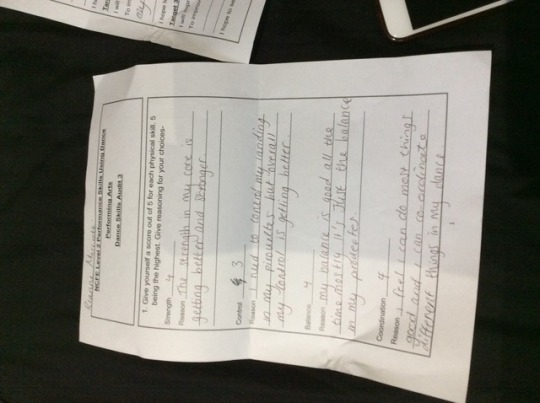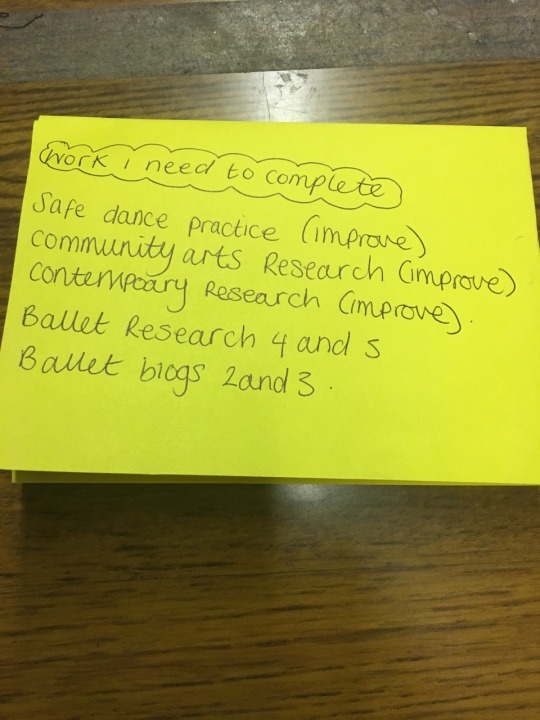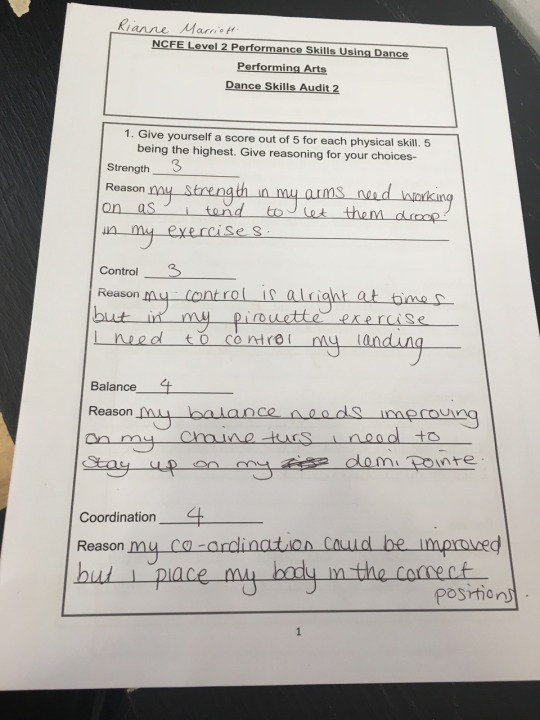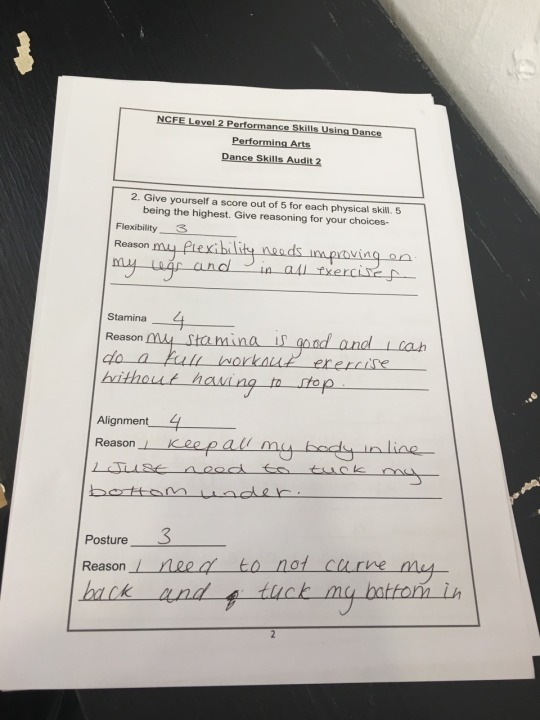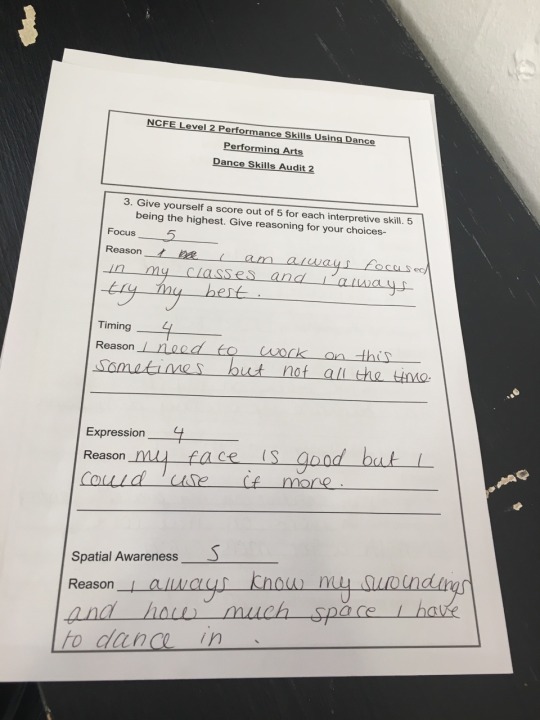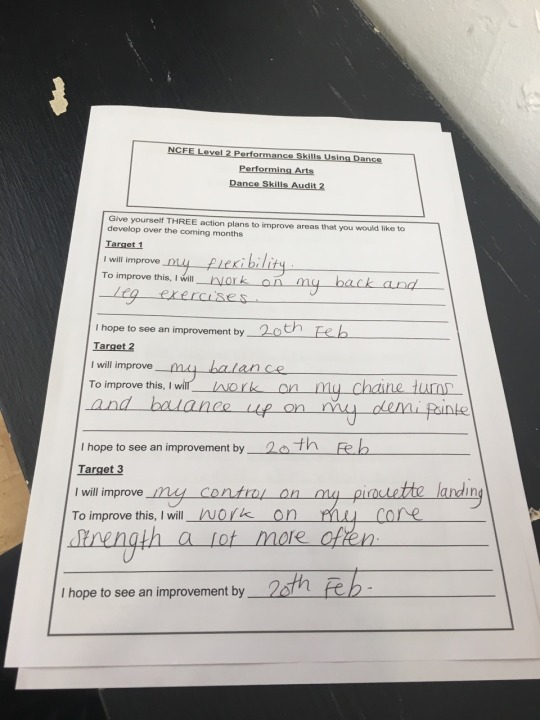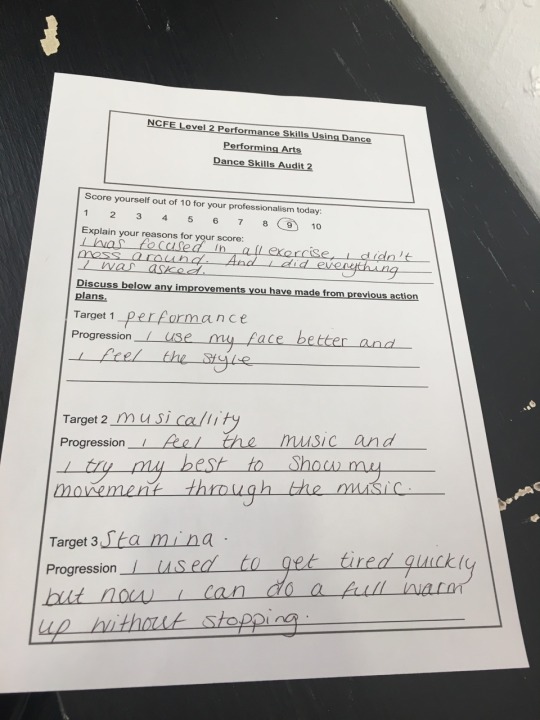Don't wanna be here? Send us removal request.
Photo
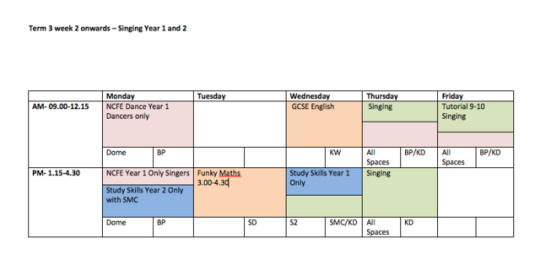
Singers timetable week 2 onwards term 3
2 notes
·
View notes
Text
Ballet essay
Ballet first originated in the Italian renaissance courts. It first began in the 15th century. The renaissance courts was a very good period of culture change and achievement, this began in Italy and it was in the 14th century and lasted up until the 16th century. Ballet spread to France, and it was with the help of Catherine de’ Medici. Where ballet was developed and spread even further under her influence. The first ever formal court ballet was staged in 1573, and it was called ballet des polonais. Originally the ballers were performed by royalty in their rooms and their gardens, which then spread on to performing for other people on royalty.
Academie royale de musique was founded in 1669, it was know as d’opera and it was such a big milestone in history, and this meant that quite a lot of dancer were associated with operas.
Court ballet was ballet performances that were performed in the 15th century up until the 17th century in the courts.
Pierre Beauchamps was the creator of the five foot positions in ballet, Beauchamps was know as the ultimate ballet master.
The first court ballet was performed in rooms and gardens of aristocracy and royalty. The first ever performance was called ballet comique de la reine it was a very well known performance and this was performed in 1581,
In the 18th century women abandoned corsets for floating styled dresses and this emphasised their body and meant that they could perform a great range of movements, they also started to ware flat ballet slippers which showed great flexibility in their feet and women began to develop the trick of rising up onto their demi pointe.
The 18th Century was best known for because of king George, and he was a mad king a lot of the public were going mad as they couldn’t handle the information on new technology after the industrial revolution. But also as this was going off some good things were happening such as pointe shoes were beginning to become invented and more people were started to see dance in different ways and it was expressed massively.
Three famous ballet masters from this period
Hester Booth
Nancy dawson
George Balanchine
Cralos Blasis was born in Naples on the 4th November 1797 Carlo was an Italian dancer and choreographer and is well known for his very rigorous dance classes which these sometimes lasted for hours long. Blasis insisted in his students learning their theory and definitions of all dance steps. some well known pieces were the code of Terpsichore, on the ballet, and theory of the art of dancing.
Here I’ve attached a YouTube video of a ballet from the 18th and 19th century
https://www.youtube.com/watch?v=y94SdIlmjbQ&list=PLdcONZVimCyl2_xh2nBp0TnIlKH3DQNI2
in this video they are wearing shoes with heels on which is very different to now. There movements are very upbeat and jump whereas these days ballet is very gentle and elegant. They are spinning around and jumping from foot to foot a lot of the time. They use their feet a lot and jump around most of the dance.
https://www.youtube.com/watch?v=-EjfGgvsldM
The plie’s and routines have become a lot quicker and shorter, movements have also become more modern and developed and made harder in some places.But all the positioning of the feet has always stayed the same throughout the centuries.
http://www.vam.ac.uk/content/articles/o/origins-of-ballet/
Romantic ballet was a big style of ballet in the early nineteenth century. The dancers were often performed in romantic tutu, these were long tulle skirts that would either go down to their knees or to their ankles. This is why it was called romantic ballet.
Marie Taglioni was from sweden and was a ballet dancer from the romantic ballet era she influenced it a lot, and she became one of the first people to dance on pointe. She also created a new style which was marked by floating leaps. The tutu was created to expose her foot work. She was one of the best ballet dancers anyone had seen, she was well known all over the world
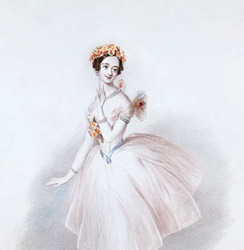
The romantic costumes changed throughout the era starting off as a long dress that went down to the ankles it was very light floaty material, it then progressed onto being a tutu which was also long but it went out more and was a little higher it was very good for showing their elegant movements. The final change to the costume was the tutu but more improved it was higher as it only went to knee height which helped the audience to see their leaps and leg work so much better and clearer.
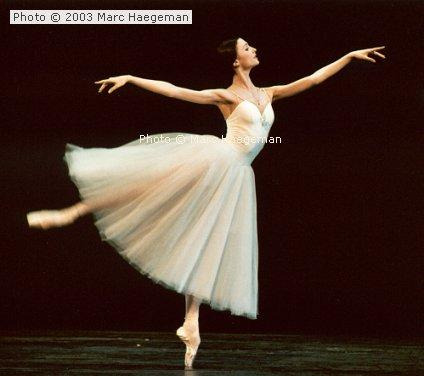
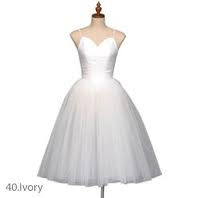
some famous romantic ballets for this period.
LA Sylphide
Giselle
Coppelia
Giselle- I like this performance I think that it is very elegant, and they make the dance look pretty, i can see their is a story through the dance, and I like the fact that their is a story within the music and dance it makes it very intriguing! But something I don’t like about the dance is that quite a lot of the dancers are just in the back and they are still, I feel they need to get involved with the story/dance more if that was possible.
British ballet;
Britain took ballet to a wider audience, they did this by travelling the UK doing tours, they did this during the war time. Swan lake was a very big ballet performance and was well known and is still well known all over the world, but It also influenced many people from the UK to the style of ballet.
Marie Rambert;
Marie was born in 1888, she really wanted to be a professional dancer for many years but her family didn’t agree with this and so they made her study medicine instead but when the first world war began she moved to Britain to teach dance in private homes and schools. Marie married a man called Alex Duke who supported her in her work of dance which meant she went on to owning her own dance school, she has her own company called ballet Rambert and even today it is very well known!
https://www.britannica.com/biography/Marie-Taglioni
http://www.vam.ac.uk/content/articles/r/romantic-ballet/
http://www.rambert.org.uk/about-us/our-history/dame-marie-rambert/
The Royal Danish Ballet and the Imperial Ballet of the Russian Empire were founded in the 1740s and began to flourish, especially after about 1850. in 1907 the Russian ballet turned back to France. in the 20th century styles of ballet continued to develop and spread out throughout the world.
Marius Petipa was a French and Russian ballet dancer and choreographer. Petipa was known to be one of the most influenced ballet dancer in the whole of history. He has performed loads of well known shows such as swan lake and giselle, but at that time them ballets were as successful as they are to this day, they are now the most popular dance pieces ever! Marius invented a performance called La fille du pharon this piece ended up to be one of the most successful pieces of that time. In 1869 he was made the premier ballet master of the imperial theatre.
Michel Fokine was a Russian dancer and choreographer, he was a very talented dancer and musician, he also was a very good painter. Fokine attended the imperial ballet school at a very young age in 1889. Fokine believed that the mime should have only been used when it was necessarily needed, he said that it had no meaning to it unless they expression different emotions throughout their dancing piece. Michel started his last ever piece of ballet which was called Helen of Troy, which was for the American ballet theatre, before he passed away but his piece was finished by a man called David Lichine and the ballet was premièred at Mexico city in 1942.
George Balanchine is a huge influence into Ballet in the USA. Find out how Balanchine adapted ballet into a more modern way and what classical pieces he recreated.
George Balanchine is a ballet choreographer, he was the co-finder of the New York City ballet in1948, and he stayed as its director and choreographer, nearly every ballet company have performed parts of his work. Balanchine presented the company with many well known pieces one being the Nutcracker. He also took a like in to choreographing for Hollywood movies and musicals which were in the Broadway. All of his work never really had a specific meaning, he felt that the dance should be equally as good as the dancer dancing the piece.
http://russiapedia.rt.com/prominent-russians/opera-and-ballet/marius-petipa/
https://www.britannica.com/biography/Michel-Fokine
https://www.nycballet.com/Explore/Our-History/George-Balanchine.aspx
Classical ballet is formal, it is actually the most formal style out of modern and contemporary, they are very strict sticking to there set of rules. Classical ballet is very well known for its movement and technique, and it also includes pointe work. Contemporary ballet include both modern and classical into its movements and techniques, this allows the body to flow into anyway it possibly wants to because there isn’t a strict ballet rule applied to contemporary.
Modern dance was founded in the 20th century, it is a very well known style and it is also known to go against the traditional rules of ballet. Isadora Duncan was the originator of modern dance and is known for using his upper body movements. Martha Graham is another practitioner who had a different outlook on this style of dance, which included contractions, spine/back work and different ways of pointing the feet and the positioning.
Ballerina’s now a days need to be bale to use their skills and adapt to them, they need to be able to be open to all idea’s including new and old ones, they like to look out for exciting things that they haven’t seen before or things that can take to the next level. Bussell thinks that modern dance “21st century stars would do well to learn to be incredibly diverse” He also said that the dancers today need to bringing something to the dance to keep it high in fame and following the history tradition.
William Forsythe was born in 1949, in New York City. He didn’t start dancing until he was in his teens, later on in his life he was given the job of an artistic director of ballet Franfrut which was made into one of the best dance companies of all time.
Methods of training: Research into Cecchetti ballet training and find out who created this method and what makes it different to other methods. What skills can be learnt from this method?
Who is AugusteBournoville? What type of ballet did he create? Discuss the method of training and how he choreographed pieces, e.g. by using his observations. What skills could be learnt from this method?
http://www.vam.ac.uk/content/articles/c/classic-ballet/
https://danceappreciation4.wordpress.com/classical-ballet/
1 note
·
View note
Text
Ballet Evaluation
TECHNIQUE
During rehearsal what was your professionalism like?
I was on time to all the lessons that I attended to, and i was in my correct dance wear. I made sure to warm up when I got into lesson so that i didn’t pull anything throughout the lesson. I stayed focused throughout the lesson and was ready in position for most of my exercises. If I was to have done anything differently I would have made sure to go through my exercises more so that I was more confident with the exercises.
When receiving feedback, how did you respond to this?
I took my notes on board for what I would need to improve on. I also mentioned these into my blogs for my weaknesses and some targets in which they said i was to improve on. Some feedback I thought I was already doing but other parts of the feedback i agreed to and I tried to work on this during each lesson.
How have you developed in ballet from the start of the unit?
I feel that I’ve learnt a massive amount of terminology during the unit as I only knew the few common ones like to plie, demi and soute. I feel that I’ve learnt a lot of different technique from this style and I’ve seen how important ballet is to do for all of our other styles of dance. I’ve learnt how to be more fluent and graceful with my dancing, and to use my core strength, focus and balance a lot more.
What were your strength’s in your technique class today?
I had good performance, I feel that i always had my head up I was always focused and made sure that I never broke my professionalism. Another things that is my strength today will be that I had good movement memory. The exercise name would be said and I would know instantly where I need to be facing and what position of the feet is required for that exercise. A final strength today is that I maintained a good turn out in my exercises and when i went into my plies i got low down into them.
What were your weaknesses in your technique class today?
When doing my pirouettes I got round and finished of the pirouettes but I wasn’t whipping myself round, I had no power behind my pirouette. Another weakness that I discovered from today is that when doing my arabesque, lifting the leg I begin to start to wobble and I can feel myself being very unstable, and to stop this from happening i need to squeeze everything and all my core. My final weakness that I found from today is that when I do my pas de bure my feet aren’t going in the right order I need to make sure that I don’t just step I need to make sure that I actually understand the steps required for the exercise.
Provide three targets for your weaknesses
PERFORMANCE
Discuss the things that went well for you in your final performance today
How did you apply your knowledge of technique to the dance?
How do you think you did with the performance side of your assessment?
What were your strengths in your performance today?
What were your weaknesses in your performance today?
If you were to do your performance again, what would you do differently and why?
0 notes
Text
Ballet blog 5
Today’s lesson was started off how last weeks was, we had to write into our note pads three targets in which we would want to work on and improve for the end of the lesson.
work on core strength
work on full extending legs and arms
work on doing a full pirouette with correct feet and good control.
We then only focused on a few of the exercises today as we needed to get a lot of the repertoire work done. The exercises focused on today were glissade essemble, par de bure’s, grande jetes on tourant and then sissiones.
For the next part of the lesson we moved onto our dance. We went through what we did last week and then also Beth who had been picked for the solo part went through her little part. We added some more to the routine. Three couppe triplet, balance, courrue to drop your left leg down and your right arm down leaning over the leg, we then repeated this on the other side, did a round house kick and jumped into relevay to face the back of the room. this is all the we added on to the dance. I feel that I did alright with picking this up and getting the legs and everything in the correct positioning.
what I need to work on this week is working on my core strength and to improve this i’m going to keep doing my core exercises like sit ups that we do in our jazz class. i also need to look into the terminology so that I know it all so I’m going to start revising it more when I’m home and having a few minutes of sitting around doing nothing. And my final improvement that I need to look at is balance so that I can hold all my positions with good posture and without falling out of movements.
My good points from this week will be keeping my legs pulled up tight and locked in when they join together. I also feel that I remembered all my exercises with good technique used. I feel that I was very focused and ready for all the exercises in this weeks lesson.
0 notes
Text
Ballet blog 4
In today’s lesson we started off by getting our note pads and writing down three things we wanted to improve or work on in the lesson, to have bettered our self by the end of the lesson on that improvement. My three targets were
Pulling up my legs
working on my pirouettes landing
pulling my bum in on my plie and not to lean forward has it ruins my posture and makes it look messy.
After we had wrote down three things we warmed up our joints and main body parts and started off with the barre work that I have mentioned in other previous blogs. We then moved into the centre and covered the floor/centre work that I have also mentioned in previous blogs.
Once we had finished all these exercises we started our repertoire work, this is a piece of dance that we must perform for our assessment. The piece of work that we are looking at is from the Nutcracker, it is called The waltz of the flowers. Before starting to learn the piece we were to watch a video clip of some professionals learning this dance piece. Within the dance there was a solo part, in which we had to all learn this part and then next week were going to vote on who we think suits this part best. So we went over the solo part a few times to get it into our heads so that we could practice at home. Towards the end of the lesson we all learnt apart of the group dance that we would be starting on next week so that we got a rough idea of what the dance is going to be like.
For this weeks strengths I pulled up my legs a lot better which is one of my targets, my balance in my arabesque is better as I wasn’t wobbling as much and I could control myself better, I understood my glidesas now.
What I need to improve from this week is working on getting my leg high on the grande battement, I need to still keep working on my double pirouettes. I need to correct the full plie position (pull my back up and pull my bottom in)
0 notes
Text
Ballet blog 3
Today we started the lesson off by doing our regular barre work, which includes, warm up rises, plies, battement tendu and battement glisse, rondus degarbie a terie develope, grande battement en cloch. We then went onto our main exercises that are done in the centre, these are pirouettes, glissade assembles, pas de bouree, tempsleve petite jetes, sissones, jetes, grande jetes tourant, and batterie
The strengths that I found from today’s lesson were that I remembered the exercises, I remembered all the notes that were given to improve, and I also had good spotting within my pirouettes as I could feel the power and whip behind it which helped me to get round.
The weaknesses that I discovered in today’s lesson was in my arabesque I couldn’t hold it for long as I kept wobbling out of it, I also need to improve on my back flexibility as it is very stiff. I need to maintain a good posture throughout so that my presentation doesn’t look sloppy.
Targets for today’s lesson that have given myself is one being flexibility within my back, working on my double pirouettes, and then grande jete on turn en, for me not to swing my leg round when I jump onto my landing leg.
From today’s lesson I improved one of my target’s which was working on my leg swinging round, I made it more of a swish under which help me out a lot with the routine it’self .
Next week I’m going to work on my landings for my double pirouettes.
0 notes
Text
@beckylangford1983
Dance Research
What is contemporary?
Contemporary dance is a genre of dance that was created in the mid twentieth century. It has grown massively and has became one of the main styles of dance, it has inspired many people throughout the years including famous and none famous people. It is an expressive style that have been influenced mainly through ballet and the main founder on contemporary dance is Rudolf Laban. In my research I’m going to be exploring 3 different dance practitioners, these 3 practitioners I’m about to talk about were all equally influenced by the contemporary style.
Martha Graham!
Graham was an American and modern dance/choreography who influenced on dance and was compared with the influence of Picasso, on the modern visual arts. She danced and choreographed for seventy years and was the very first dancer to perform at the white house. Graham started teaching a small group of dancers who were drawn to her dance styles and techniques in 1926. She influenced generations of dancers and choreographers such as Merce Cunningham. She loved to dance ballet but she twisted it up a bit by pointing with a straight leg instead of a turned out leg and she also liked to put in contractions which is more of an modern style of dance move. She also liked the idea of using your back in different way throughout your performances. During her long and illustrious career, Graham created 181 masterpiece dance compositions, which continue to challenge and inspire generations of performers and audiences. Her style is mainly described as being powerful and and sharp. As a dancer which I have personally danced her style I feel that it is very different to anything before I feel that she was very brave to show off her way of dance and the changes in this, as many people will feel that this is strange, as at first it is hard to get into doing this style but the more practice you get you start to feel that Graham’s style of dance is actual a good style to welcome into the dancing history.
Merce Cunningham!
Cunningham was an American dancer and choreographer who developed his new forms of abstract dance movements. He was born in 1919 on the 16th of April and died on the 26th of July 2009. Cunningham was taught by Graham, she saw him dancing and invited him into her dance school, he stayed there for six years, and was influenced a lot by her. He became a solo dancer, and became a teacher in the black mountain college. He choreographed more that 200 dances. One of his main features was working the spine, he used different movements, like tilt, and spiral. Cunningham first experienced dance while living in Centralia. He took tap class from a local teacher, who taught him to love music and gave him a clear understanding of musicality. He published a book with Francis Star, which contained a different sketches of both their contemporary movements. Because of Cunningham being influenced and taught by Martha Graham his dance and style is very similar to hers, but he Incorporated some of his own movements such as the five positions of the spine which were curved, tilt, twist, upright and arched, this was a very important part of his work as it showed how different movements were made from the use of the spine. Another key dance style by Cunningham was chance theory as he believed using chance theory made his dancer a lot more human oriented, he would normally choreograph his dance without music then when the dance was all finished he would put on music and make the dancers dance the piece to the song of choice and they would have to make it fit by changing pace, height or even use cannon. I feel that this kind of style means that you have to have good flexibility in the back which I don’t have, also feel that the chance theory is very risky as it may not work out at the end.
Alvin Ailey!
Ailey first joined the Horton’s company, when Horton died in November 1953 the tragedy left the company without an artistic director. The company had outstanding contracts that required and desired new workers. When no one else stepped forward for the job, Ailey assumed the role of artistic director. Despite his youth and lack of experience. Ailey was only 22 years old and had choreographed only one dance in a workshop, he began choreographing, directing scene and costume designs, and running rehearsal and he also directed one of the shows for the company. Ailey once observed Martha Graham’s modern dance of contemporary, but he found it “finicky and strange” and disliked the technique of jose’ limon as well. He couldn’t find any work that was like Horton’s and so began to create is own work, which he creates based on slavery and freedom, as he was living in the great depression age. This style of dance is very slow and very well placed, you have to have a lot of emotion behind your movements and show that you have a story to tell behind every movement that you dance, I like this style as I like to use emotions in my performance but what i don’t like about dancing this style is that it is very repetitive and also it’s very slow pace dancing whereas I prefer upbeat dancing.
3 notes
·
View notes
Text
Ballet research five
Classical ballet is formal, it is actually the most formal style out of modern and contemporary, they are very strict sticking to there set of rules. Classical ballet is very well known for its movement and technique, and it also includes pointe work. Contemporary ballet include both modern and classical into its movements and techniques, this allows the body to flow into anyway it possibly wants to because there isn’t a strict ballet rule applied to contemporary.
Modern dance was founded in the 20th century, it is a very well known style and it is also known to go against the traditional rules of ballet. Isadora Duncan was the originator of modern dance and is known for using his upper body movements. Martha Graham is another practitioner who had a different outlook on this style of dance, which included contractions, spine/back work and different ways of pointing the feet and the positioning.
Ballerina’s now a days need to be bale to use their skills and adapt to them, they need to be able to be open to all idea’s including new and old ones, they like to look out for exciting things that they haven’t seen before or things that can take to the next level. Bussell thinks that modern dance “21st century stars would do well to learn to be incredibly diverse” He also said that the dancers today need to bringing something to the dance to keep it high in fame and following the history tradition.
William Forsythe was born in 1949, in New York City. He didn’t start dancing until he was in his teens, later on in his life he was given the job of an artistic director of ballet Franfrut which was made into one of the best dance companies of all time.
Methods of training: Research into Cecchetti ballet training and find out who created this method and what makes it different to other methods. What skills can be learnt from this method?
Who is AugusteBournoville? What type of ballet did he create? Discuss the method of training and how he choreographed pieces, e.g. by using his observations. What skills could be learnt from this method?
·
CONCLUSION: What do you think has influenced the development of classical ballet?
http://www.vam.ac.uk/content/articles/c/classic-ballet/
https://danceappreciation4.wordpress.com/classical-ballet/
0 notes
Text
Ballet research task four
The Royal Danish Ballet and the Imperial Ballet of the Russian Empire were founded in the 1740s and began to flourish, especially after about 1850. in 1907 the Russian ballet turned back to France. in the 20th century styles of ballet continued to develop and spread out throughout the world.
Marius Petipa was a French and Russian ballet dancer and choreographer. Petipa was known to be one of the most influenced ballet dancer in the whole of history. He has performed loads of well known shows such as swan lake and giselle, but at that time them ballets were as successful as they are to this day, they are now the most popular dance pieces ever! Marius invented a performance called La fille du pharon this piece ended up to be one of the most successful pieces of that time. In 1869 he was made the premier ballet master of the imperial theatre.
Michel Fokine was a Russian dancer and choreographer, he was a very talented dancer and musician, he also was a very good painter. Fokine attended the imperial ballet school at a very young age in 1889. Fokine believed that the mime should have only been used when it was necessarily needed, he said that it had no meaning to it unless they expression different emotions throughout their dancing piece. Michel started his last ever piece of ballet which was called Helen of Troy, which was for the American ballet theatre, before he passed away but his piece was finished by a man called David Lichine and the ballet was premièred at Mexico city in 1942.
George Balanchine is a huge influence into Ballet in the USA. Find out how Balanchine adapted ballet into a more modern way and what classical pieces he recreated.
George Balanchine is a ballet choreographer, he was the co-finder of the New York City ballet in1948, and he stayed as its director and choreographer, nearly every ballet company have performed parts of his work. Balanchine presented the company with many well known pieces one being the Nutcracker. He also took a like in to choreographing for Hollywood movies and musicals which were in the Broadway. All of his work never really had a specific meaning, he felt that the dance should be equally as good as the dancer dancing the piece.
http://russiapedia.rt.com/prominent-russians/opera-and-ballet/marius-petipa/
https://www.britannica.com/biography/Michel-Fokine
https://www.nycballet.com/Explore/Our-History/George-Balanchine.aspx
0 notes
Text
NCFE Dance blog 2
In today’s lesson we started off with the high intensity warm ups and dance techniques, which we cover at the start of every dance lesson. During today’s lesson we focused on the next set of exercises that we were taught in lesson. The first exercise we covered was our pirouettes, these are mainly focused on control for us the getting the correct positioning of the body and the correct landing from coming out of the turn. The balance of your pirouette is very important as you need to balance up on your demi pointe as you are rotating yourself around in a full circle. I feel that my pirouette spotting is very good and I maintain a good posture throughout the exercise but my landing from out the turn is very poor and to improve this I need to work on my core strength.
The next exercise that we went onto were three lifts from the floor, the first one being attitude, the second is a T shape and the final position is the arch. This exercise requires a lot of strength for you to be able to push yourself up from off the floor. It also uses balance for when you’re in the position you need to be able to hold it without wobbling and the final thing it uses is flexibility in the back on the arch and attitude position as you need to be able to arch your back as much as you can and keep your head back and looking upwards. I feel that I am good at the arch one as I can hit the perfect position, but my back needs better flexibility and I need to work on staying in my T position because I find it difficult to hold it so I need to work on my arm strength and the timing of going in and out of this position.
The third exercise was our back exercise. We do a Y, W, and T shape with our arms and we lay on our front. The aim for this exercise is to strengthen the back and increase the flexibility in your back. In the exercise you need to lift your arms of the ground but you mist make sure that your arms are level with your head, and that you hold it in the air for a certain amount of counts before relaxing back to the ground. This exercise requires core strength and flexibility in your back. I feel that I’m not too great at this exercise as my back strength and flexibility isn't very good, and to improve on this I need to work on doing this exercise more than once as week, but if i had to say I was doing something good it would be the positioning of my body is very good at all times throughout this exercise.
The final exercise that we did today was kicks laid on the floor, the kicks are on both legs and we do this on our back and laid on our side. We kick our legs two times and on the third kick we get hold of our leg pull it as far to our head as we can to stretch it out, then we repeat this over on both legs, laying onto both side of the body on the floor. This requires flexibility to stretch the leg and get it high, it also requires a good amount of control so that when you kick the leg it falls back to the floor with control. I feel that I need to work on the flexibility in my legs as I need to be able to get them higher, I also need to keep my hips pushed forward and my supporting leg flat on the floor. I think that my legs are nicely controlled in this exercise.
0 notes
Text
Ballet blog two
In today’s lesson we started off by warm up our bodies. Some of the things we did were rolling the ankles, stretching and flexing our feet and stretching over our legs. It is essential to warm up the body and stretch out everything because we don’t want to cause injury to ourselves while we are dancing.
We then went to the barre and did our exercises. Warm up rises, plies in first, second, and third. Battement tendu and battement glisse. Rondus degarbie a terie develope. Grande battement en cloche. After the barre we move into the center to begin our exercises, we focused on only a few of these today so that we got them all neat and tidy and went through them throughly, the exercises worked on today are; pirouettes, glissade assembles, pas de bouree, tempsleve petite jetes. All of this exercises help with your control, strength in the arms and legs and with your technique to all different styles of dancing. They also teach you the correction posture and positioning.
My weaknesses
My first weakness is sticking my bum out when I do my plies. I need to make sure that when I bend that I pull everything in and control it.
I need to also make sure then whenever I come in from a foot position my legs glue back together and you can see them working, and also that my knees are strong and not saggy.
my final weakness is to sort out posture, I need to make sure that the flexibility in my back is better as I never pull up from it and I’m also hunched.
My strengths
My first strength is that on my pirouettes the spotting is really good and I whip myself around
I had good balance on my arabesque, and I maintained my focus.
My final strength is that I could remember the exercises that I had learnt and I could keep in time with the music.
My targets.
I need to improve on my flexibility as I’m very stiff I can do this by doing the back strengthening exercise that we have to do in our Jazz class with Becky.
I also need to work on my landing from my pirouettes. I’m going to do this by working on strengthening my core strength.
0 notes
Text
Ballet research task three
What defines the romantic ballet era? Why is it called romantic ballet?
Romantic ballet was a big style of ballet in the early nineteenth century. The dancers were often performed in romantic tutu, these were long tulle skirts that would either go down to their knees or to their ankles. This is why it was called romantic ballet.
Who is Marie Taglioni?
Marie Taglioni was from sweden and was a ballet dancer from the romantic ballet era she influenced it a lot, and she became one of the first people to dance on pointe. She also created a new style which was marked by floating leaps. The tutu was created to expose her foot work. She was one of the best ballet dancers anyone had seen, she was well known all over the world
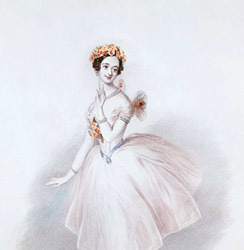
What was the common costume for the Romantic Ballet?
The romantic costumes changed throughout the era starting off as a long dress that went down to the ankles it was very light floaty material, it then progressed onto being a tutu which was also long but it went out more and was a little higher it was very good for showing their elegant movements. The final change to the costume was the tutu but more improved it was higher as it only went to knee height which helped the audience to see their leaps and leg work so much better and clearer.
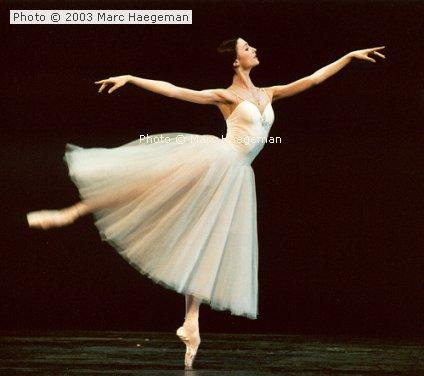
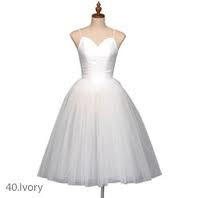
Name some famous romantic ballets for this period.
LA Sylphide
Giselle
Coppelia
Giselle- I like this performance I think that it is very elegant, and they make the dance look pretty, i can see their is a story through the dance, and I like the fact that their is a story within the music and dance it makes it very intriguing! But something I don’t like about the dance is that quite a lot of the dancers are just in the back and they are still, I feel they need to get involved with the story/dance more if that was possible.
British ballet;
Britain took ballet to a wider audience, they did this by travelling the UK doing tours, they did this during the war time. Swan lake was a very big ballet performance and was well known and is still well known all over the world, but It also influenced many people from the UK to the style of ballet.
Marie Rambert;
Marie was born in 1888, she really wanted to be a professional dancer for many years but her family didn’t agree with this and so they made her study medicine instead but when the first world war began she moved to Britain to teach dance in private homes and schools. Marie married a man called Alex Duke who supported her in her work of dance which meant she went on to owning her own dance school, she has her own company called ballet Rambert and even today it is very well known!
https://www.britannica.com/biography/Marie-Taglioni
http://www.vam.ac.uk/content/articles/r/romantic-ballet/
http://www.rambert.org.uk/about-us/our-history/dame-marie-rambert/
0 notes
Text
NFCE Dance blog one
In today’s lesson we started off by doing high intensity warm ups which helps to warm up our muscles and bump blood around our bodies this is done by making the heart beat fast, it also works various parts of our body to high intensity. It is important to do this as we don’t want to be pulling anything during our dance lesson.
The technique exercises that were covered in today’s lesson were
- Demi plie, in this exercise you need to have good control, you also need balance and flexibitility in your hips, legs and feet
- Full plie in this exercise you need control again, flexibility in your hips, legs and feet and you also need to balance and strength when going into full plie as you don’t want to be sitting into it so strength to hold yourself up correctly.
-Table back exercise you need flexibility in your back, and control on going into the table back.
- Tendu
- Jumps in first, second and third switching the foot each time finishing with a box jump. you need stamina, good flexibility, and control.
-preperation for front kick, front kicks and a hitch kick on both right and left leg. this requires good balance and also good flexibility, you need to have good control when bringing the leg back down to the ground.
Strengths
I have good control when bring my legs down after my kicks
I have good focus throughout the exercises
I had good stamina when I was doing my jumps, and I felt my toes were pointed nicely throughout the exercise.
Weaknesses
i need to make sure that I straighten my legs when I do the kicks
I also need to spot on my pirouettes so that I don’t land badly.
I need to make sure that I work on my flexibility more in my back and legs.
0 notes
Photo

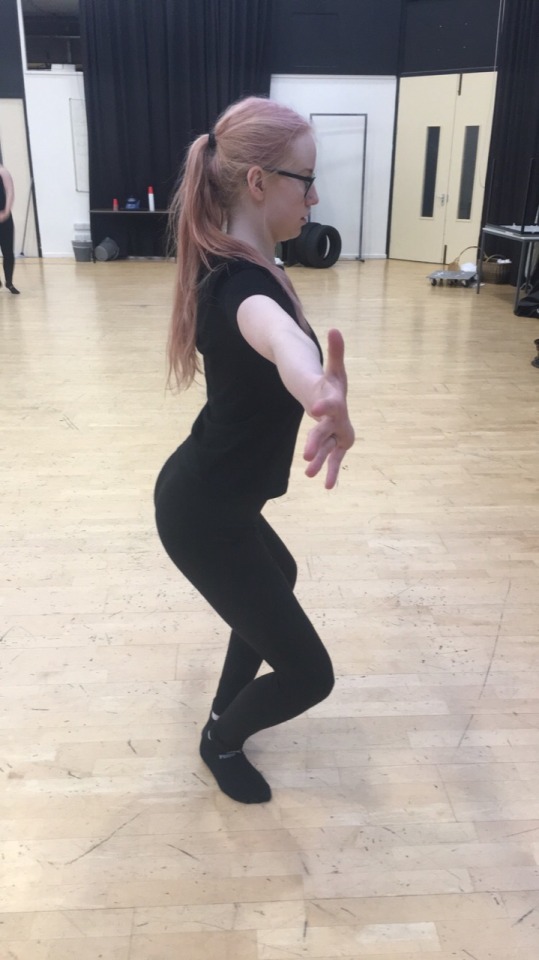
On the flat back I need to go down further and stretch the back out more, and this means I need to work on the flexibility of my back. In the plié I need to not stick my bum out and so I need to pull up my centre more and control the bend
1 note
·
View note
